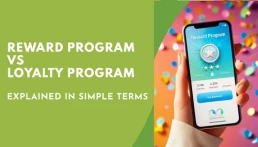
We are often asked to compare Reward Programs vs Loyalty Programs, what are they exactly and how do they differ from each other? And more importantly, which is most suitable for certain business goals and needs?
If you run a business, you might have already heard of reward programs and loyalty programs as ways to increase customer retention and loyalty. In this article, we will explain how reward programs and loyalty programs differ and what the pros and cons of each of them are.
Reward Programs
A reward program is a marketing strategy that offers customers incentives or benefits for performing certain actions, such as making purchases, referring friends, writing reviews, etc. The incentives can be in the form of points, discounts, coupons, freebies, cashback, etc. The main purpose of a reward program is to motivate customers to repeat their behavior and increase their spending.
Advantages of reward programs:
- Attract new customers and increase sales volume.
- Create a sense of urgency and excitement among customers.
- Encourage customers to try new products or services.
- Reward specific behavior /action – instant gratification
- Consistently well-managed can also enhance customer satisfaction and loyalty.
Some of the disadvantages of a reward program are:
- It can be costly and complex to implement and manage.
- It can reduce profit margins and affect cash flow.
- It can create unrealistic expectations and entitlement among customers.
- It can dilute the brand value and differentiation.

Loyalty Programs
A loyalty program is a marketing strategy that offers customers long-term benefits or privileges for being loyal to a brand, such as exclusive access, personalized service, recognition, etc. The benefits can be in the form of tiers, statuses, badges, clubs, communities, etc. The main purpose of a loyalty program is to build emotional connections with customers and increase their lifetime value.
Advantages of loyalty programs:
- Retain existing customers and reduce churn rate.
- Create a sense of belonging and appreciation among customers.
- Quality programs foster customer advocacy and word-of-mouth.
- By delivering value will strengthen brand perception and reputation.
Disadvantages of the loyalty program:
- Without sound metrics can be difficult to measure and quantify impact and return on investment.
- Challenging to maintain customer engagement and interest over time without continuous effort and budget
- Can alienate or frustrate customers who do not qualify or benefit from the program.
- Can create legal or ethical issues if not managed properly across the various locales.
Reward Programs vs Loyalty Programs - which is Better?
When you compare Reward Programs vs Loyalty Programs, there is no definitive answer as to which is better, It will depend on factors such as your business model, target market, customer behavior, budget, etc. However, here are some general guidelines :
- If you want to boost short-term sales and attract new customers, a reward program might be more effective, where motivation or reward is provided to elicit a specific action or behavior
- If you want to increase and encourage retention over the long term, a loyalty program might be more suitable, where the member continues to be rewarded for ongoing participation.
- If you want to achieve both goals, you might consider combining both strategies or creating a hybrid program that offers both short-term rewards combined longer-term benefits.
In conclusion, reward programs and loyalty programs are different marketing strategies. Each has advantages and disadvantages. Depending on your business objectives and/or campaign needs, you should choose the approach that best fits. Remember that, like any marketing activity it should be an iterative process being refined based on response and feedback, with the ultimate goal being to create value for both you and your customers.
